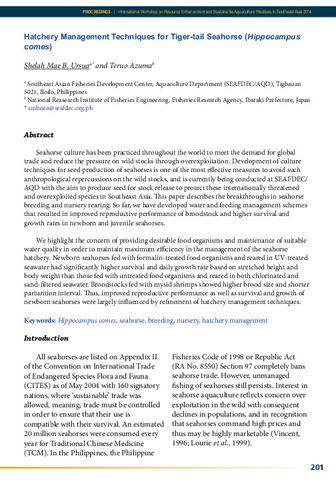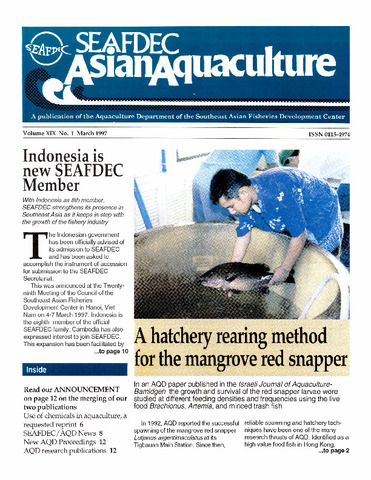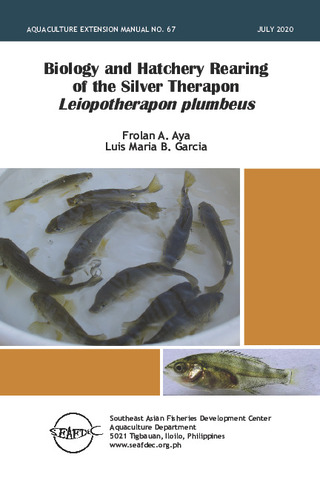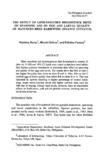Hatchery management techniques for tiger-tail seahorse (Hippocampus comes)
Share
Abstract
Seahorse culture has been practiced throughout the world to meet the demand for global trade and reduce the pressure on wild stocks through overexploitation. Development of culture techniques for seed production of seahorses is one of the most effective measures to avoid such anthropological repercussions on the wild stocks, and is currently being conducted at SEAFDEC/ AQD with the aim to produce seed for stock release to protect these internationally threatened and overexploited species in Southeast Asia. This paper describes the breakthroughs in seahorse breeding and nursery rearing. So far, we have developed water and feeding management schemes that resulted in improved reproductive performance of broodstock and higher survival and growth rates in newborn and juvenile seahorses.
We highlight the concern of providing desirable food organisms and maintenance of suitable water quality in order to maintain maximum efficiency in the management of the seahorse hatchery. Newborn seahorses fed with formalin-treated food organisms and reared in UV-treated seawater had significantly higher survival and daily growth rate based on stretched height and body weight than those fed with untreated food organisms and reared in both chlorinated and sand-filtered seawater. Broodstocks fed with mysid shrimps showed higher brood size and shorter parturition interval. Thus, improved reproductive performance as well as survival and growth of newborn seahorses were largely influenced by refinement of hatchery management techniques.
Suggested Citation
Ursua, S. M. B., & Azuma, T. (2015). Hatchery management techniques for tiger-tail seahorse (Hippocampus comes). In M. R. R. Romana-Eguia, F. D. Parado-Estepa, N. D. Salayo, & M. J. H. Lebata-Ramos (Eds.), Resource Enhancement and Sustainable Aquaculture Practices in Southeast Asia: Challenges in Responsible Production of Aquatic Species: Proceedings of the International Workshop on Resource Enhancement and Sustainable Aquaculture Practices in Southeast Asia 2014 (RESA) (pp. 201-206). Tigbauan, Iloilo, Philippines: Aquaculture Dept., Southeast Asian Fisheries Development Center.
Subject
seed (aquaculture)  ; growth rate
; growth rate  ; feeding
; feeding  ; live feeds
; live feeds  ; stocking (organisms)
; stocking (organisms)  ; trade
; trade  ; feeds
; feeds  ; Tropical fish; survival
; Tropical fish; survival  ; seed production
; seed production  ; rare species
; rare species  ; breeding
; breeding  ; overexploitation
; overexploitation  ; stocks
; stocks  ; Ornamental fish; reproduction
; Ornamental fish; reproduction  ; breeding stock
; breeding stock  ; species extinction
; species extinction  ; aquaculture techniques
; aquaculture techniques  ; fish culture
; fish culture  ; Hippocampus comes; Philippines; Seahorse; Breeding; Nursery; Hatchery management; hatcheries
; Hippocampus comes; Philippines; Seahorse; Breeding; Nursery; Hatchery management; hatcheries 
 ; growth rate
; growth rate  ; feeding
; feeding  ; live feeds
; live feeds  ; stocking (organisms)
; stocking (organisms)  ; trade
; trade  ; feeds
; feeds  ; Tropical fish; survival
; Tropical fish; survival  ; seed production
; seed production  ; rare species
; rare species  ; breeding
; breeding  ; overexploitation
; overexploitation  ; stocks
; stocks  ; Ornamental fish; reproduction
; Ornamental fish; reproduction  ; breeding stock
; breeding stock  ; species extinction
; species extinction  ; aquaculture techniques
; aquaculture techniques  ; fish culture
; fish culture  ; Hippocampus comes; Philippines; Seahorse; Breeding; Nursery; Hatchery management; hatcheries
; Hippocampus comes; Philippines; Seahorse; Breeding; Nursery; Hatchery management; hatcheries 
Related items
Showing items related by title, author, creator and subject.
-
A hatchery rearing method for the mangrove red snapper
Castaños, Milagros T.; Southeast Asian Fisheries Development Center, Aquaculture Department (Aquaculture Department, Southeast Asian Fisheries Development Center, 1997) -
Biology and hatchery rearing of the silver therapon Leiopotherapon plumbeus
Aya, Frolan; Garcia, Luis Maria (Aquaculture Department, Southeast Asian Fisheries Development Center, 2020-07)Known for its tasty flesh, silver therapon, locally known as ayungin, has been regarded to be one of the most valuable edible native freshwater species in the Philippines. Demands for this fish species remain high which ... -
The effect of lipid-enriched broodstock diets on spawning and on egg and larval quality of hatchery-bred rabbitfish (Siganus guttatus)
Duray, Marietta; Kohno, Hiroshi; Pascual, Felicitas (San Carlos Publications, University of San Carlos, 1994)Three isocaloric and isonitrogenous diets formulated to contain 12 (diet A), 15 (B) and 18% (C) lipids were tested on hatchery-bred rabbitfish Siganus guttatus broodstock to determine their effect on spawning and quality ...




